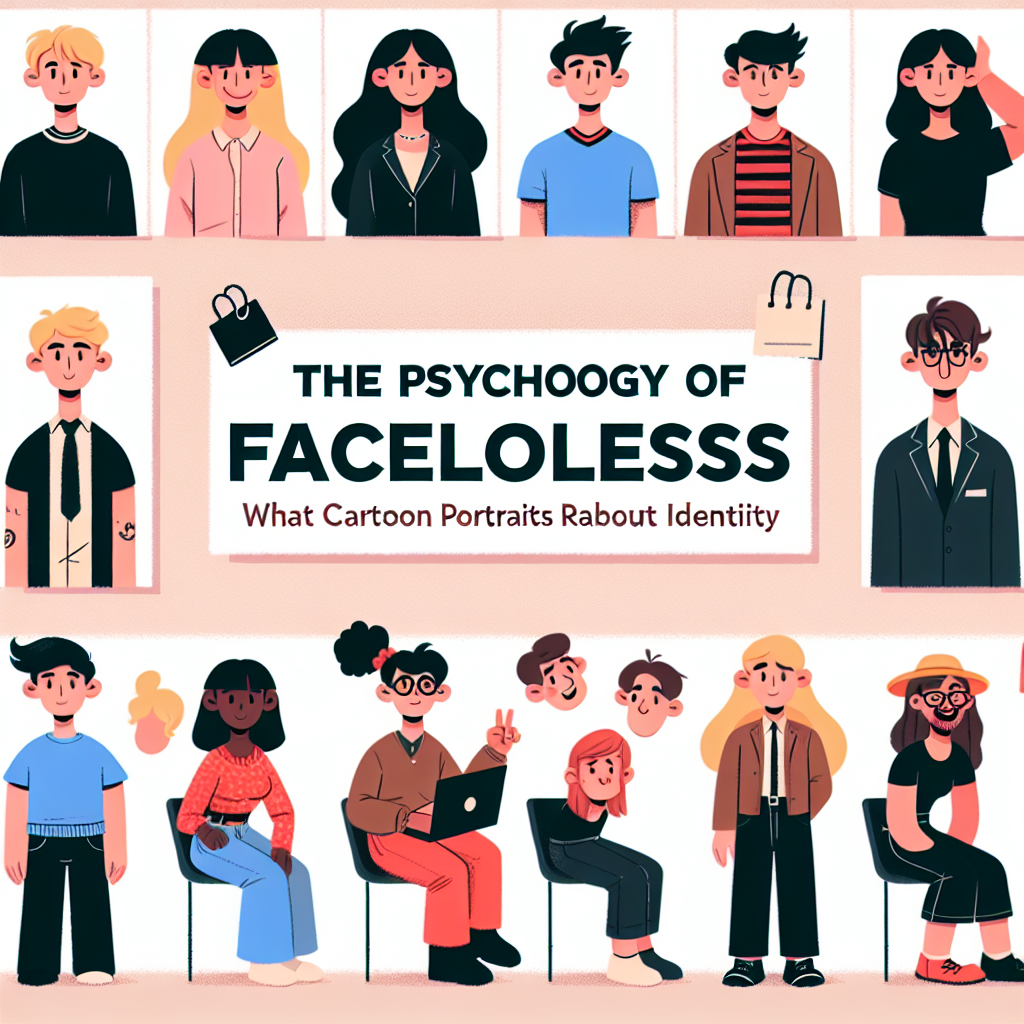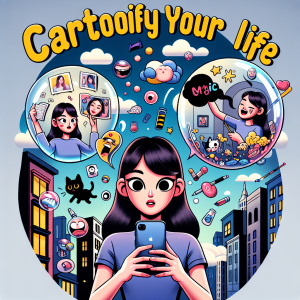Imagine scrolling through social media and coming across a colorful array of cartoon portraits—their faces blank, their features simplified, yet still bursting with personality. At first glance, these faceless characters might seem merely whimsical, casual digital avatars. However, they open a fascinating window into the complex interplay of identity and self-representation in our modern society. So why do we find ourselves drawn to these faceless figures? What do they say about us and how we craft our identities in a world saturated with images?
The Rise of Facelessness in Digital Culture
In the era of digital communication, our identities have begun to shift from the tangible to the intangible. Social media platforms are littered with profiles that feature cartoon avatars instead of real-life photos. This trend allows individuals to express themselves through stylized visuals that often lack defining human characteristics but overflow with personal flair. But what drives this faceless depiction?
Psychological Freedom and Anonymity
One significant reason behind the allure of facelessness lies in the psychological freedom that anonymity provides. The lack of recognizable features offers users a chance to express themselves without the constraints of societal expectations. It’s liberating! You can be whoever you want to be—whether it’s a fierce superhero or a goofy animal. Many find themselves relating through these simplified portraits, allowing them to bypass the fear of judgment that often accompanies personal photos.
This anonymity also creates a unique space for creativity. People can play with colors, styles, and attributes that reflect their inner selves more profoundly than a mere photograph could. In allowing our imaginations to run wild, faceless cartoon portraits become a canvas for self-exploration and experimentation, aiding in the expression of aspects of our identities that may otherwise go suppressed.
Reducing Bias and Judgment
Faceless avatars can serve as equalizers. In a world where first impressions are often based on appearances, these cartoon portraits remove certain biases related to race, gender, age, and socio-economic status. Think about it—an audience can focus on the content of what someone shares rather than the preconceived notions tied to their physical appearance. This shift in perspective encourages more authentic engagement and dialogue, as users are drawn to the individuality expressed through personality rather than traditional traits.
Exploring Identity Through Creativity
Creating a cartoon avatar is often an intuitive act of self-expression. Users can carefully select colors, styles, and symbols that resonate with their experiences and aspirations. This creativity is deeply personal; it’s like crafting a visual language that encapsulates the essence of who someone believes they are. Some may gravitate towards jovial characters reflecting their cheerful demeanor, while others may embody serious or fantastical figures to channel their deeper aspirations.
This exploration can also lead to a greater understanding of self. The process of creating a faceless avatar often prompts introspection—pondering questions like, “What colors represent my energy?” or “Which traits do I wish to project?” This self-reflection can be both therapeutic and empowering, fostering a more profound sense of identity in the digital realm.
Facelessness and Shared Experience
Another intriguing aspect of these cartoon portraits is their ability to foster a sense of community. When individuals present themselves through shared stylistic elements—like face masks or oversized glasses—it indicates conformity to a subset of cultural or community values. This can be particularly attractive in online environments where users seek recognition and belonging.
Facelessness can help establish common ground. These cartoon versions of ourselves become symbols of shared interests, merging disparate identities into a unified visual language. Whether it’s gaming, fandoms, or niche communities, the faceless avatar becomes an identifier—muted yet strong enough to bond individuals, beckoning them on shared adventures in a virtual space.
Facelessness: A Double-Edged Sword
While the magic of facelessness is multifaceted, it can also harbor pitfalls. The detachment from self presented through faceless avatars can lead to disconnection from reality. For some, it may become challenging to engage in genuine interactions when behind a simplified mask. The allure of these cartoon personas may entice individuals to present a curated version of themselves rather than the complete image, leading to superficial exchanges devoid of deeper connection.
Additionally, the detachment afforded by facelessness comes with its own psychological impacts. As individuals immerse themselves in their created identities, it might become tricky to discern where the avatar ends, and the individual begins. This blurring of lines can create existential questions surrounding authenticity and self-worth—do these avatars reflect who we truly are, or are they merely a collection of aspirations constructed through pixels?
Facelessness and Modern Identity Politics
In an era where identity politics and representation have come to the forefront, facelessness can also intersect with broader movements advocating for change. Faceless avatars often symbolize anonymity in activism, where individuals rally around a common cause while preserving personal privacy. This aspect of facelessness creates an empowering arena for collective voices to be heard without fear of individual repercussions.
On the other hand, this may create an avenue for misrepresentation, as facelessness can sometimes cloud accountability. The digital anonymity allows harmful behaviors—such as trolling or misinformation—to thrive under the guise of an intangible identity. Striking a balance between embracing anonymity for empowerment versus recognizing its potential for misuse can be challenging, yet crucial for creating a conscientious online environment.
Social Media Influencers and the Faceless Phenomenon
Many social media influencers have adopted a brand of facelessness, utilizing cartoon or simplified versions of themselves to represent their online personas. This strategy can build intrigue, allowing followers to explore differing facets of identity without the trauma of exposure that public figures often face. The faceless nature cultivates a ‘mystery’ factor that engages audiences while crafting a relatable façade that promotes connection.
Moreover, influencers may use these avatars to reinforce their brand—faceless cartoon representations give a clean, scalable model of identity that can reach a wider audience while maintaining relatability. The whimsical and playful nature of these representations can be especially effective in industries focusing on lifestyle, wellness, and fun.
The Future of Identity and Facelessness
As technology continues to evolve, so too will our methods of self-representation. Augmented reality filters and advanced AI are rapidly pushing boundaries, allowing for even deeper customization of digital identities. We stand at a crossroads, where facelessness may serve both as a tool for agency and self-discovery as well as a complicating force in the pursuit of understanding one’s authentic self.
As we embrace these developments, it’s essential to maintain our core inquiry: what does this mean for our understanding of identity? The adventure into the realm of facelessness is not merely about searching for personal expression, but rather delving into what those expressions reveal about the ever-evolving human experience.
Conclusion: Embracing Our Faceless Selves
The world of cartoon portraits and faceless avatars explores rich dimensions of identity—challenging conventions while fostering creativity and self-exploration. They allow us to illustrate personal traits in way that reveals much more than meets the eye. The next time you find yourself crafting a faceless digital identity, take a moment to reflect on what it represents. What are you trying to say? What do you wish to express? In the whimsical world of facelessness, each pixel tells a story waiting to be discovered.
FAQ
Why do people use cartoon avatars instead of real images?
Many individuals choose cartoon avatars for reasons such as anonymity, self-expression, and creativity. Faceless representations allow people to present a version of themselves without the pressure of societal expectations, providing greater freedom to express their inner thoughts and feelings.
How do faceless portraits influence online communication?
Faceless portraits can reshape online communication by reducing bias based on physical appearance. They encourage users to engage with each other based on personality and shared values, rather than preconceived notions about race, gender, or age. This often leads to more genuine dialogue and community building.
Are faceless avatars a form of escapism?
In some cases, yes. Faceless avatars can allow users to explore different aspects of their identity in a safe, creative space. However, it’s essential to balance this exploration with real-life engagement to avoid becoming disconnected from one’s true self.
Can facelessness be harmful?
While facelessness can foster anonymity and creativity, it can also lead to superficial connections and a lack of accountability in online spaces. Misrepresentation and harmful behavior may emerge when individuals hide behind faceless avatars, making it crucial to use this expression responsibly.
How can I create a meaningful cartoon avatar?
To create a meaningful cartoon avatar, reflect on the attributes you want to express. Consider colors, styles, and elements that resonate with your personality or aspirations. Try to intertwine genuine traits with your artistic preferences, creating a balance that feels true to you.








+ There are no comments
Add yours